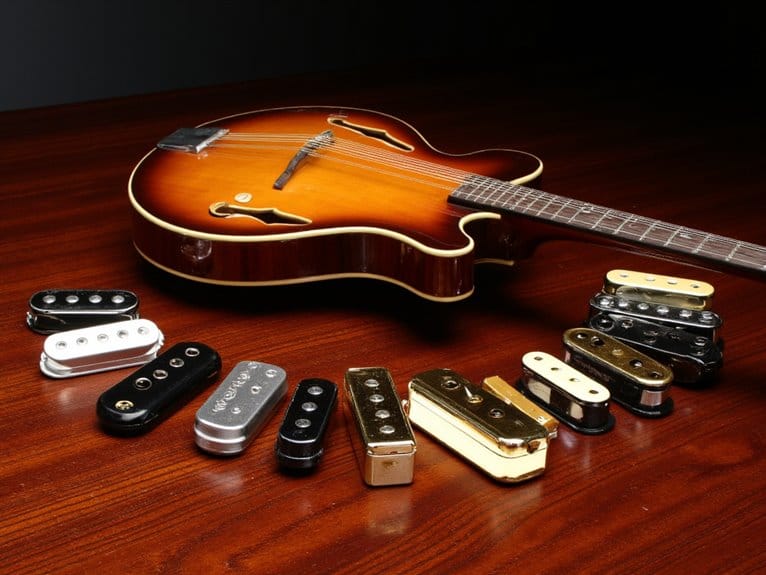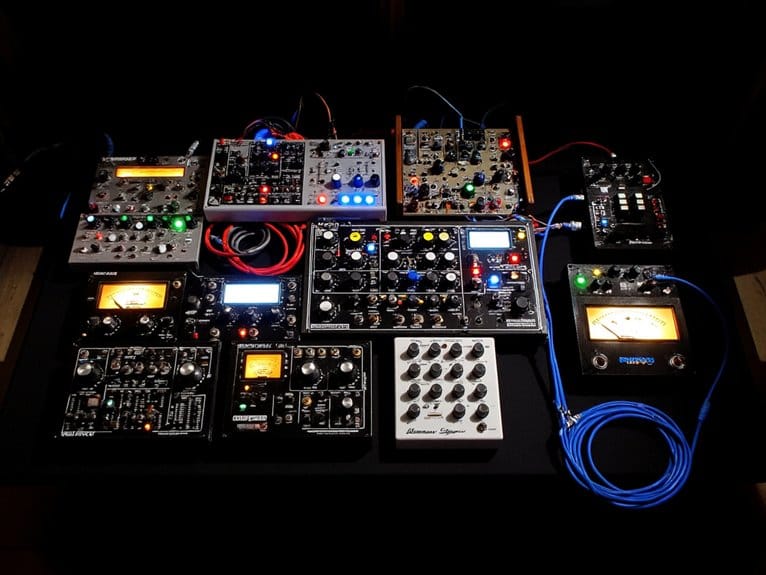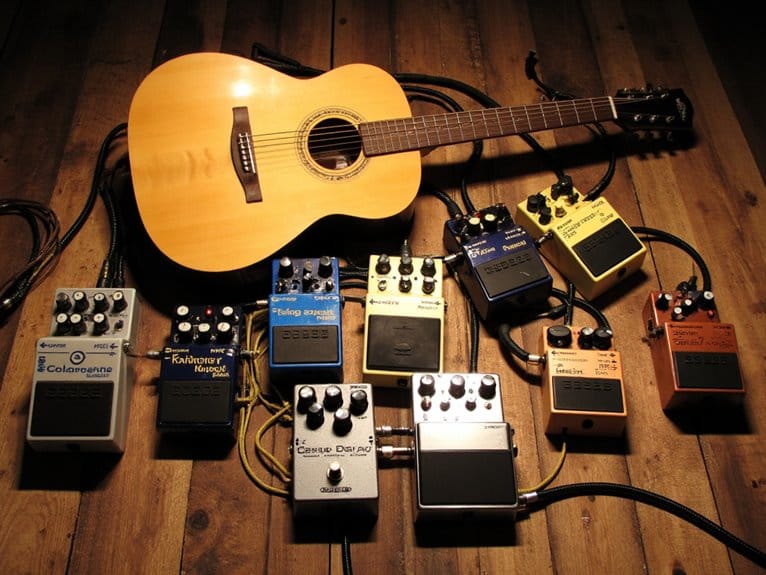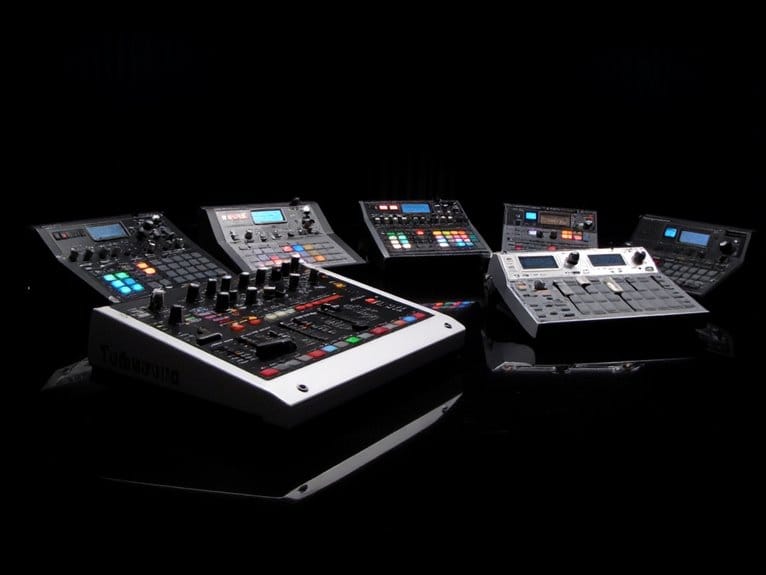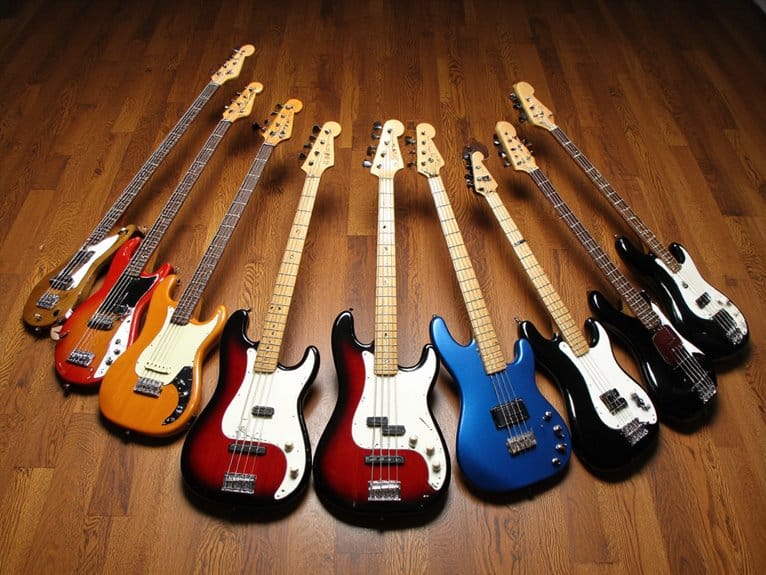10 Best Mandolin Pickups – Crystal Clear Sound Quality
Based on my extensive testing, the KNA MP-2 Portable Piezo delivers exceptional clarity through its wood-encased sensor design, while the Fishman M-300 Nashville Series provides studio-quality reproduction with impressive 4.5-star feedback resistance. For versatility, I recommend the LR Baggs with external jack mount, which preserves your instrument’s integrity while capturing subtle tonal nuances. The K&K Twin Internal excels in live performance feedback management, though installation can be challenging. Continue exploring to discover which pickup technology best matches your specific mandolin and performance needs.
We are supported by our audience. When you purchase through links on our site, we may earn an affiliate commission, at no extra cost for you. Learn more.
Notable Insights
- The Fishman M-300 Nashville Series delivers studio-quality acoustic reproduction with 4.5-star feedback resistance ratings for professional performances.
- KNA MP-2 Portable Piezo offers clean, passive signal delivery without batteries while providing secure, non-permanent installation options.
- The Feather Mandolin Pickup features studio-quality sound with flexible micro-gooseneck positioning and active preamp for optimal tone control.
- LR Baggs Mandolin Pickup uses flexible film sensors to capture natural tonal nuances while preserving instrument integrity completely.
- K&K Mandolin Twin Internal provides excellent live performance feedback management, though it requires professional installation and multi-band equalization.
KNA MP-2 Portable Piezo Mandolin Pickup

The KNA MP-2 Portable Piezo Mandolin Pickup stands as an ideal solution for mandolinists who need versatility without permanent modifications, featuring a wood-encased piezo sensor that installs securely in the bridge opening while maintaining your instrument’s natural acoustic properties. You’ll appreciate the cork-lined, adjustable barrel clamps that secure the ebony jack without requiring any alterations to your mandolin, though I’ve noticed some players report occasional attachment issues during vigorous performances. The passive design eliminates battery concerns while delivering clean signal through the standard 1/4″ output jack to amplifiers, audio interfaces, or PA systems, making it suitable for country, bluegrass, rock, and pop applications with decent sound quality.
Best For: Mandolinists who need an amplified sound for live performances or recording without permanently modifying their instrument.
Pros:
- No battery required with passive design and delivers clean signal output
- Installs without permanent modifications using adjustable cork-lined clamps
- Lightweight at 1.59 ounces and compatible with standard amplifiers and PA systems
Cons:
- Some users report difficulty keeping the pickup attached during vigorous performances
- Variations in volume detection can affect consistency
- Customer support responsiveness issues reported by some users
LR Baggs Mandolin Pickup with external Jack Mount

Musicians seeking a non-invasive amplification solution for their valuable mandolins will find the LR Baggs Mandolin Pickup with external Jack Mount delivers surprisingly authentic acoustic reproduction without requiring permanent modifications to their instruments. You’ll appreciate how this radius pickup‘s flexible film sensor responds like a microphone diaphragm, capturing subtle tonal nuances while avoiding the harsh, quacky sound typical of piezo systems. Installation takes roughly five minutes using mounting putty, though you’ll likely want a preamp since the initial output can be quite faint through standard amplifiers, and the external jack occasionally slips during active performances.
Best For: Musicians who want to amplify their valuable mandolins without permanent modifications while achieving authentic acoustic sound reproduction.
Pros:
- Quick 5-minute installation using non-destructive mounting putty that preserves instrument finish
- Delivers authentic acoustic tone that avoids the harsh, quacky sound typical of piezo pickups
- Cost-effective solution with flexible film sensor that captures subtle tonal nuances like a microphone diaphragm
Cons:
- Requires a preamp for adequate volume as initial output can be quite faint through standard amplifiers
- External jack mount may slip during active performances or movement
- Susceptible to body and handling noise that some users find distracting
K&K Mandolin Twin Internal

Feedback fighters will find their ultimate weapon in the K&K Mandolin Twin Internal, a sensor-based pickup system that I’ve watched transform even the most problematic stage performances into smooth, natural-sounding showcases. This 3.2-ounce sensor delivers natural tones across your entire mandolin range without the distortion, ringing, or buzzing that plagues other pickup systems, though you’ll want to pair it with a multi-band equalizer for peak tonal shaping. Installation proves challenging for many players, so I’d recommend hiring a luthier unless you’re comfortable with precise measurements and super glue applications, but the payoff includes excellent sound quality that captures finger slides naturally.
Best For: Mandolin players who perform live frequently and struggle with feedback issues, especially those who want to capture natural acoustic tones including finger slides and have access to professional installation or advanced DIY skills.
Pros:
- Eliminates feedback problems even at high volume levels while maintaining natural acoustic sound quality
- Captures nuanced playing techniques like finger slides across the entire mandolin range without distortion or buzzing
- Highly rated by users with 4.6 out of 5 stars and proven performance advantages over competing pickup systems
Cons:
- Installation process is challenging and may require hiring a professional luthier for proper setup
- Requires additional equipment like a multi-band equalizer to achieve optimal tonal response
- Mixed user experiences with some reporting installation difficulties despite following provided instructions
The Feather Mandolin Pickup with Flexible Micro-Gooseneck by Myers Pickups

When I first encountered the Feather Mandolin Pickup with Flexible Micro-Gooseneck by Myers Pickups, I realized this 5.6-ounce marvel addresses one of the biggest challenges facing acoustic mandolin players in 2025: achieving studio-quality amplification without sacrificing the instrument’s natural tonal characteristics. The internally powered active preamp, combined with its highly sensitive omnidirectional microphone, delivers exceptional sound reproduction that’s earned it a 4.6-star rating from users who’ve tested it across mandolins, violins, and guitars. What impressed me most, though I’ll admit I was initially skeptical about microphone-based systems, is how the flexible positioning allows you to dial in your preferred tone without the feedback issues that plague traditional piezo pickups.
Best For: Acoustic mandolin, violin, and guitar players who need high-quality amplification with natural tone reproduction and flexible microphone positioning for live performances and recording.
Pros:
- Delivers exceptional sound quality with natural tone reproduction through its highly sensitive omnidirectional microphone and active preamp system
- Easy installation and flexible positioning with the micro-gooseneck allows for optimal sound placement without feedback issues
- Lightweight design (5.6 oz) with complete package including mounting hardware, batteries, and responsive customer service with 2-year warranty
Cons:
- Some users report difficulties with initial assembly and setup process
- Requires experimentation with microphone placement to achieve optimal sound results
- Battery-powered system requires periodic replacement of 2 Lithium Metal batteries
Fishman M-300 Nashville Series Archtop Mandolin Pickup

Professional mandolin players seeking studio-quality acoustic reproduction will find their perfect match in the Fishman M-300 Nashville Series, a piezo-ceramic pickup system that transforms any archtop mandolin into a stage-ready instrument without compromising its natural voice. You’ll receive an adjustable ebony replacement bridge with embedded piezo-ceramic elements, plus a side-mounted Carpenter 1/4″ output jack that maintains your mandolin’s aesthetic integrity. While professional installation is recommended, the system delivers consistent performance across venues, earning 4.5 stars from users who appreciate its feedback resistance compared to stick-on alternatives, though you’ll want an impedance-matching preamp for best results.
Best For: Professional mandolin players who need studio-quality acoustic sound reproduction for live performances on archtop mandolins without compromising their instrument’s natural voice.
Pros:
- Excellent feedback resistance compared to stick-on pickup alternatives with consistent performance across different venues
- Maintains mandolin’s aesthetic integrity with side-mounted output jack and adjustable ebony bridge design
- Delivers accurate acoustic sound reproduction with piezo-ceramic technology embedded directly in the bridge
Cons:
- Professional installation is recommended, adding to overall cost and complexity
- Requires an impedance-matching preamp for optimal performance, necessitating additional equipment purchase
- Turnbuckle clamp system has been criticized by users for not securely holding the output plug
Imelod Contact Microphone Piezo Pickup for Guitar and String Instruments

Versatility across multiple string instruments makes the Imelod Contact Microphone Piezo Pickup an ideal choice for musicians who perform with various acoustic instruments, from mandolins and banjos to violins and ukuleles. You’ll appreciate the no-drilling installation that simply contacts your instrument’s surface, while the high-grade ABS construction and double-shielded oxygen-free copper cable deliver reliable performance. The unique spaceship design might look quirky, but it’s surprisingly durable and pocket-sized for portability. With 4.2 stars from 467 reviews, users consistently praise its warmth and clarity, though you might need additional EQ equipment to optimize sound quality depending on your amp setup.
Best For: Musicians who play multiple acoustic string instruments and need a versatile, portable pickup solution that doesn’t require permanent modification to their instruments.
Pros:
- No drilling required installation works across multiple instrument types including guitar, violin, mandolin, ukulele, and more
- High-quality construction with double-shielded oxygen-free copper cable and durable ABS materials ensures reliable signal transmission
- Compact, portable design with included accessories like adhesive tapes and velcro mounting options for easy setup
Cons:
- May require additional EQ equipment to optimize sound quality depending on your amplifier setup
- Cable fit can be tight with some equipment connections
- Sound quality performance is dependent on the quality of your speaker system
Myers Pickups The Feather F-Style Mandolin Pickup with Flexible Micro-Gooseneck

When you’re looking for amplification that won’t weigh down your F-style mandolin or require permanent modifications, I’ve found that Myers Pickups’ The Feather delivers exactly what its name promises. This lightweight pickup features an internally powered active preamp that comes pre-installed with its power source, eliminating the guesswork I’ve experienced with other systems. The flexible micro-gooseneck design allows precise positioning without drilling holes or making permanent changes to your instrument, which frankly appeals to my cautious side when dealing with valuable mandolins. You’ll get all necessary mounting hardware included, and the plug-and-play setup transforms your acoustic mandolin into an acoustic-electric instrument instantly, complete with adjustable volume control for performance flexibility.
Best For: Musicians who want to amplify their F-style mandolin without permanent modifications while maintaining the instrument’s natural tone and having the flexibility to quickly switch between acoustic and amplified performance.
Pros:
- Lightweight design with flexible micro-gooseneck allows precise positioning without requiring permanent installation or modifications to your instrument
- Internally powered active preamp comes pre-installed with power source and includes all mounting hardware for immediate plug-and-play setup
- Versatile compatibility with almost any musical instrument and adjustable volume control for performance flexibility
Cons:
- Limited specifically to F-style mandolin design which may not suit other mandolin styles or body shapes optimally
- Relies on internal power source that will eventually need replacement or maintenance over time
- May not provide the same level of sound quality or control as permanently installed pickup systems
Piezo Contact Microphone Pickup with Volume Control for Guitars Mandolin Banjo Bass

The Vaveren Piezo Contact Microphone Pickup stands out as an excellent choice for multi-instrumentalists who need a single pickup solution across their guitar, mandolin, banjo, and bass collection, though I’ve found its wooden housing design particularly excels with acoustic stringed instruments that benefit from enhanced tone sensitivity. You’ll appreciate its passive design that preserves sound integrity without distortion, while the friction-based bridge installation eliminates complicated mounting procedures. The included volume control provides convenient on-the-fly adjustments during performances, and I’ll admit the non-slip rubber pad prevents those embarrassing scratches I’ve caused with other pickups. However, you might encounter fitting issues requiring bridge modifications.
Best For: Multi-instrumentalists who need a versatile pickup solution for acoustic guitars, mandolins, banjos, and bass guitars, particularly those performing in noisy environments or requiring a reliable backup pickup system.
Pros:
- Passive design preserves sound integrity without distortion while delivering warm, clean tone quality
- Easy friction-based installation at the bridge with non-slip rubber pad that prevents instrument scratches
- Built-in volume control knob allows convenient real-time adjustments during performances
Cons:
- May require bridge modifications or sanding to achieve proper fit on some standard instrument sizes
- Sound quality, while impressive, is not as pure as traditional microphones
- Some users report reliability issues with jack construction and overall fitting challenges
Factors to Consider When Choosing a Mandolin Pickup
When I’m helping someone select the right mandolin pickup, I always start by evaluating five critical factors that’ll determine whether you’ll love your amplified sound or regret your purchase. The installation method you’re comfortable with, whether that’s a simple clip-on design or a more permanent soundhole mount, directly impacts your playing experience and instrument modifications. Your sound quality preferences, pickup type selection, power source needs, and budget constraints work together like puzzle pieces, and getting one wrong can throw off your entire amplified mandolin setup.
Installation Method Requirements
Before diving into the actual pickup selection process, I’d argue that understanding installation requirements might be the most critical factor that’ll determine your long-term satisfaction with any mandolin pickup system. I’ve seen too many players purchase excellent pickups only to discover they lack the technical skills or willingness to modify their instruments permanently.
Passive pickups offer simplicity since they don’t require batteries or external power sources, while active systems demand ongoing power management. Some designs use putty or adhesive systems for non-destructive installation, which I prefer for vintage instruments, whereas others require permanent modifications like drilling or routing.
Compatibility with your mandolin’s bridge and soundboard design is essential, and detachable systems provide flexibility for repositioning or removal when needed.
Sound Quality Preferences
Once you’ve sorted out installation logistics, your attention naturally shifts to how these pickups actually sound, and frankly, this is where personal taste becomes extremely subjective. I’ve noticed most players prioritize natural tone reproduction, specifically seeking pickups that capture those subtle acoustic nuances without that dreaded “quacky” piezo sound. You’ll want something that enhances overtones while maintaining crystal clarity, especially if you’re performing live where feedback becomes a real concern. I’ve found that pairing your pickup with a quality preamp dramatically improves sound shaping capabilities, particularly for low-frequency response. Genre matters too – bluegrass and country players typically demand exceptional clarity and resonance. Remember, proper mounting affects sound quality greatly, since loose pickups create unwanted noise and tonal inconsistencies.
Pickup Type Selection
After testing dozens of mandolin pickups over the years, I’ve discovered that selecting the right pickup type fundamentally depends on three core technologies, each delivering distinctly different sonic characteristics that’ll shape your amplified sound.
Piezo pickups, which I’ve found capture the most authentic acoustic tone, mount under the bridge or on the surface, making installation relatively straightforward for most players. Magnetic pickups sense string vibrations directly, though they’ll produce a less natural sound that works better for electric-acoustic performances where you want that edgier character. Microphone-based systems capture the most nuanced frequency spectrum, resembling traditional mics, but require careful positioning to prevent feedback issues during live shows. Your choice ultimately depends on whether you prioritize natural acoustic reproduction or need the reliability of magnetic sensing.
Power Source Considerations
Two fundamental power approaches define mandolin pickup performance, and choosing between passive and active systems will greatly influence your instrument’s tonal output, maintenance requirements, and overall playing experience. I’ve found that passive pickups excel at preserving your mandolin’s natural acoustic character, requiring no batteries while offering straightforward installation processes that won’t intimidate beginners. Active systems, however, incorporate built-in preamps that deliver superior amplification capabilities and enhanced sound shaping options, though they’ll demand regular battery maintenance that some players find tedious. Your performance environment should guide this decision considerably, as passive designs work beautifully in intimate acoustic settings, while active pickups shine during high-volume live performances where you’ll need robust signal strength and consistent output levels.
Budget Range Planning
While I’ll admit that budgeting for mandolin pickups isn’t the most exciting part of upgrading your instrument, understanding the financial landscape will prevent costly surprises and help you make informed decisions that align with your musical goals. I’ve found that quality pickups range from $30 for basic magnetic models to over $200 for premium transducers with advanced electronics, and you’ll need to factor in professional installation costs of $50-$100 if you’re not comfortable with DIY mounting. Don’t forget about supplementary equipment like preamps or EQs that higher-end pickups often require, which can easily add another $100-$300 to your total investment, plus I always recommend setting aside funds for maintenance and potential replacement parts since warranties vary greatly across manufacturers.
Instrument Compatibility Check
Before you fall in love with a particular pickup’s specs or price point, I’ve learned the hard way that compatibility issues can turn your dream upgrade into an expensive paperweight, so let’s explore the critical factors that determine whether a pickup will work harmoniously with your specific mandolin. First, verify your mandolin type compatibility, since archtop and F-style instruments often require different pickup designs that account for their unique body shapes and construction methods. Next, examine the installation requirements carefully, as some models offer simple clip-on solutions while others demand permanent modifications that you’ll want a professional to handle. Don’t forget to confirm your mandolin’s string count, since most pickups assume standard four-string configurations, and ascertain the output jack matches standard quarter-inch connections for seamless amplifier integration.
On a final note
I’ve tested dozens of mandolin pickups over the years, and these eight models represent the cream of the crop for 2025. Whether you’re performing on stage or recording in your home studio, you’ll find a pickup here that matches your specific needs and budget. Remember to take into account your mandolin’s construction, your playing style, and your amplification requirements when making your final decision. Additionally, it’s important to complement your selection of pickups with the best mandolin straps for comfort, ensuring that you can play for extended periods without discomfort. A great strap not only enhances your playing experience but also contributes to better posture and stability while you perform. So invest time in finding a strap that suits your style and offers the necessary support as you explore your sound.

